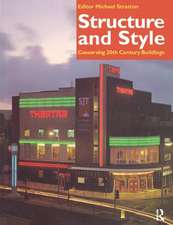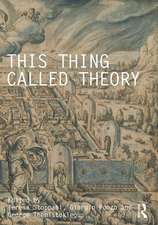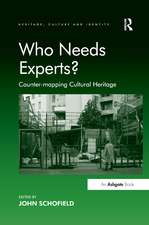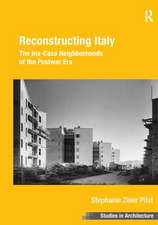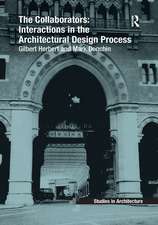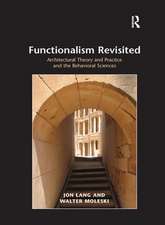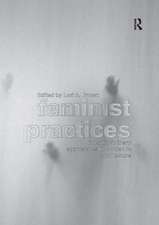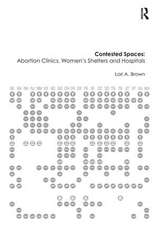Building the Inclusive City: Theory and Practice for Confronting Urban Segregation: Routledge Research in Planning and Urban Design
Autor Nilson Ariel Espinoen Limba Engleză Hardback – 2 apr 2015
This book brings together debates on ethnic and economic segregation, combining theory and practical solutions to create a guide for those trying to understand and address urban segregation in any part of the world, and integrate ameliorating policies to contemporary urban development agendas.
| Toate formatele și edițiile | Preț | Express |
|---|---|---|
| Paperback (1) | 469.34 lei 43-57 zile | |
| Taylor & Francis – 25 mai 2017 | 469.34 lei 43-57 zile | |
| Hardback (1) | 1160.47 lei 43-57 zile | |
| Taylor & Francis – 2 apr 2015 | 1160.47 lei 43-57 zile |
Din seria Routledge Research in Planning and Urban Design
-
 Preț: 327.98 lei
Preț: 327.98 lei -
 Preț: 292.40 lei
Preț: 292.40 lei -
 Preț: 294.82 lei
Preț: 294.82 lei -
 Preț: 311.41 lei
Preț: 311.41 lei -
 Preț: 154.17 lei
Preț: 154.17 lei -
 Preț: 348.21 lei
Preț: 348.21 lei -
 Preț: 311.41 lei
Preț: 311.41 lei -
 Preț: 317.06 lei
Preț: 317.06 lei -
 Preț: 340.99 lei
Preț: 340.99 lei - 31%
 Preț: 763.39 lei
Preț: 763.39 lei - 31%
 Preț: 764.20 lei
Preț: 764.20 lei - 26%
 Preț: 875.97 lei
Preț: 875.97 lei - 26%
 Preț: 846.50 lei
Preț: 846.50 lei - 18%
 Preț: 1005.01 lei
Preț: 1005.01 lei - 18%
 Preț: 1216.52 lei
Preț: 1216.52 lei - 14%
 Preț: 338.33 lei
Preț: 338.33 lei -
 Preț: 284.52 lei
Preț: 284.52 lei -
 Preț: 469.34 lei
Preț: 469.34 lei -
 Preț: 489.26 lei
Preț: 489.26 lei -
 Preț: 449.41 lei
Preț: 449.41 lei - 28%
 Preț: 823.59 lei
Preț: 823.59 lei -
 Preț: 449.41 lei
Preț: 449.41 lei - 25%
 Preț: 569.79 lei
Preț: 569.79 lei - 25%
 Preț: 767.88 lei
Preț: 767.88 lei - 24%
 Preț: 324.16 lei
Preț: 324.16 lei - 18%
 Preț: 1106.02 lei
Preț: 1106.02 lei - 26%
 Preț: 766.10 lei
Preț: 766.10 lei - 18%
 Preț: 1161.28 lei
Preț: 1161.28 lei - 18%
 Preț: 1000.27 lei
Preț: 1000.27 lei - 26%
 Preț: 819.91 lei
Preț: 819.91 lei - 18%
 Preț: 1000.13 lei
Preț: 1000.13 lei -
 Preț: 436.14 lei
Preț: 436.14 lei - 18%
 Preț: 1001.24 lei
Preț: 1001.24 lei - 27%
 Preț: 554.64 lei
Preț: 554.64 lei - 26%
 Preț: 764.20 lei
Preț: 764.20 lei - 28%
 Preț: 822.76 lei
Preț: 822.76 lei - 18%
 Preț: 1160.32 lei
Preț: 1160.32 lei - 18%
 Preț: 1000.76 lei
Preț: 1000.76 lei - 28%
 Preț: 847.34 lei
Preț: 847.34 lei - 25%
 Preț: 852.63 lei
Preț: 852.63 lei - 18%
 Preț: 1169.16 lei
Preț: 1169.16 lei - 18%
 Preț: 1111.90 lei
Preț: 1111.90 lei - 18%
 Preț: 1107.61 lei
Preț: 1107.61 lei
Preț: 1160.47 lei
Preț vechi: 1415.21 lei
-18% Nou
Puncte Express: 1741
Preț estimativ în valută:
222.13€ • 241.36$ • 186.71£
222.13€ • 241.36$ • 186.71£
Carte tipărită la comandă
Livrare economică 21 aprilie-05 mai
Preluare comenzi: 021 569.72.76
Specificații
ISBN-13: 9781138814417
ISBN-10: 1138814415
Pagini: 156
Ilustrații: 13 black & white halftones, 4 black & white line drawings
Dimensiuni: 156 x 234 x 15 mm
Greutate: 0.36 kg
Ediția:1
Editura: Taylor & Francis
Colecția Routledge
Seria Routledge Research in Planning and Urban Design
Locul publicării:Oxford, United Kingdom
ISBN-10: 1138814415
Pagini: 156
Ilustrații: 13 black & white halftones, 4 black & white line drawings
Dimensiuni: 156 x 234 x 15 mm
Greutate: 0.36 kg
Ediția:1
Editura: Taylor & Francis
Colecția Routledge
Seria Routledge Research in Planning and Urban Design
Locul publicării:Oxford, United Kingdom
Public țintă
PostgraduateCuprins
Introduction, Part I: Social Power and Urban Space, 1. Power and Difference, 2. Types of Power, 3. Power and Urban Form: Style, 4. Power and Urban Form: Location, 5. Power and Urban Segregation: A Brief Historical Review, 6. Power and Urban Segregation: The Contemporary Context, 7. Power and Land Markets, Part II: Confronting Segregation, 8. Segregation and Urban Economies, 9. Social Benefits of Urban Segregation, 10. Social Costs of Urban Segregation, 11. Searching for Inclusionary Development Patterns and Public Policies, 11. Notes on Selected Case Studies, Conclusion: Looking for New Urban Cosmologies
Notă biografică
Nilson Ariel Espino is a lecturer at McGill University’s Panama Field Study Semester, and at the Central American Master’s Program for Conservation of Cultural Heritage for Development, at the University of Panama. He also directs Panama City’s Urban Forum and Observatory and is a practicing architect and urban planner. He holds a bachelor’s degree in architecture from Santa María La Antigua Catholic University, a master’s in urban planning from the University of Arizona, and a Ph.D. in social and cultural anthropology from Rice University.
Recenzii
‘By engaging with the spatial dimensions of inequity and exclusion, the book shifts the discussion on housing laterally and embeds it more squarely in broader urbanizations and city-making processes. Espino’s experience as a practitioner brings a nuanced voice to the challenges of creating equitable urban environments in the face of the uncertainties of global capital and the disruptions it creates in cities. A refreshing contribution to the literature on cities – where Espino provokes us to not discuss inclusivity but rather how not to make our cities exclusive!’
Rahul Mehrotra, Professor and Chair, Department of Urban Planning and Design, Graduate School of Design, Harvard University
‘As many countries react to increasing levels of polarization, social exclusion and segregation by emphasizing social mix policies, it is important to understand the historical, political and anthropological reasons for our urge to segregate. Only then will we be able to make public choices that will have a chance of success. Espino’s multidisciplinary approach explains spatial choices as resulting from the exercise of power in its communicative and symbolic aspects, adding a necessary layer to the usual economic explanations.
But the book is much more than that. In Part II, dedicated to confronting segregation, Espino evaluates the social costs of segregation and – on the basis of recent research – the possible benefits of social mix, addressing issues such as social networks, peer effects, collective socialization, the culture of poverty, and the indelible scars resulting from living in high-crime areas. It concludes with a few case studies of recent projects in the Americas that promote social inclusion. What is especially wonderful about the book is that it is written in an easy, clear and breezy style, making it a pleasure to read and accessible not only to professional planners and policy-makers, but to both graduate and undergraduate students in a variety of disciplines.’
Nico Calavita, Professor Emeritus, Graduate Program in City Planning, San Diego State University, co-author of Inclusionary Housing in International Perspective: Affordable Housing, Social Inclusion and Land Value Recapture
‘This is a timely book on one of the most pervasive and difficult issues facing urban planners in Latin America and other parts of the world. With clarity and elegance it sheds light on the historical roots and geographical nuances of how and why social groups are separated/segregated in cities. With a refreshing anthropological focus on the spatial expression of society’s power hierarchies or differentials, the author pre-empts the economist’s often apologetic account of the inevitability of spatial separation of income groups.
Broadening the view beyond the "dictatorship of the highest and best use" of land, the book discusses alternative reasoning for more inclusionary social housing provision. An account is thus presented of the social costs of succumbing to segregation, but most refreshingly also an up-to-date review of some tools and effective practices for promoting residential inclusiveness.
This richly documented book offers a "must reference" for students of urban residential segregation – which should mean all who are concerned with the pitfalls for the social-economic and political sustainability of our cities.’
Martim Smolka, Senior Fellow and Director, Program on Latin America and the Caribbean, Lincoln Institute of Land Policy
‘Building the Inclusive City presents a fascinating overview of social power and how power translates into segregated populations and policies around the world. Lessons drawn from theories in planning, architecture, sociology, and anthropology, help to paint a clearer picture of what we can know about exclusion and distinctions in order to make an argument for inclusion with the aim of achieving higher levels of social equality. We look at clothing, housing and neighborhood development in North America, Europe, China and in South America in order to understand the reasons for separation and class distinction over time and how these distinctions have been solidified in our rules, regulations, policies and laws. This book then asks and demonstrates, given this tendency toward separations and class distinctions of populations, what interventions could be used to bring them back together to help build a rich tapestry of neighborhoods that embrace inclusiveness. Pushing this question one step further, this book touches on another key idea – the size of businesses and the problem of spatial monopolies in cities and whether we need to consider managing not only the mix of residences, but also the mix of businesses to protect vibrancies of street life, small businesses and natural mixing of populations that can occur. At play is the larger question for planners, architects, and policy makers: Can we begin to understand how we exclude using tools such as zoning, evictions, regulations, and laws, and if so, can we rethink our use of these tools in order to create a finer grain of mixes of populations and business in order to develop inclusive, diverse and vibrant cities?’
Cherie Miot Abbanat, Lecturer, Department of Urban Studies and Planning, Massachusetts Institute of Technology
Rahul Mehrotra, Professor and Chair, Department of Urban Planning and Design, Graduate School of Design, Harvard University
‘As many countries react to increasing levels of polarization, social exclusion and segregation by emphasizing social mix policies, it is important to understand the historical, political and anthropological reasons for our urge to segregate. Only then will we be able to make public choices that will have a chance of success. Espino’s multidisciplinary approach explains spatial choices as resulting from the exercise of power in its communicative and symbolic aspects, adding a necessary layer to the usual economic explanations.
But the book is much more than that. In Part II, dedicated to confronting segregation, Espino evaluates the social costs of segregation and – on the basis of recent research – the possible benefits of social mix, addressing issues such as social networks, peer effects, collective socialization, the culture of poverty, and the indelible scars resulting from living in high-crime areas. It concludes with a few case studies of recent projects in the Americas that promote social inclusion. What is especially wonderful about the book is that it is written in an easy, clear and breezy style, making it a pleasure to read and accessible not only to professional planners and policy-makers, but to both graduate and undergraduate students in a variety of disciplines.’
Nico Calavita, Professor Emeritus, Graduate Program in City Planning, San Diego State University, co-author of Inclusionary Housing in International Perspective: Affordable Housing, Social Inclusion and Land Value Recapture
‘This is a timely book on one of the most pervasive and difficult issues facing urban planners in Latin America and other parts of the world. With clarity and elegance it sheds light on the historical roots and geographical nuances of how and why social groups are separated/segregated in cities. With a refreshing anthropological focus on the spatial expression of society’s power hierarchies or differentials, the author pre-empts the economist’s often apologetic account of the inevitability of spatial separation of income groups.
Broadening the view beyond the "dictatorship of the highest and best use" of land, the book discusses alternative reasoning for more inclusionary social housing provision. An account is thus presented of the social costs of succumbing to segregation, but most refreshingly also an up-to-date review of some tools and effective practices for promoting residential inclusiveness.
This richly documented book offers a "must reference" for students of urban residential segregation – which should mean all who are concerned with the pitfalls for the social-economic and political sustainability of our cities.’
Martim Smolka, Senior Fellow and Director, Program on Latin America and the Caribbean, Lincoln Institute of Land Policy
‘Building the Inclusive City presents a fascinating overview of social power and how power translates into segregated populations and policies around the world. Lessons drawn from theories in planning, architecture, sociology, and anthropology, help to paint a clearer picture of what we can know about exclusion and distinctions in order to make an argument for inclusion with the aim of achieving higher levels of social equality. We look at clothing, housing and neighborhood development in North America, Europe, China and in South America in order to understand the reasons for separation and class distinction over time and how these distinctions have been solidified in our rules, regulations, policies and laws. This book then asks and demonstrates, given this tendency toward separations and class distinctions of populations, what interventions could be used to bring them back together to help build a rich tapestry of neighborhoods that embrace inclusiveness. Pushing this question one step further, this book touches on another key idea – the size of businesses and the problem of spatial monopolies in cities and whether we need to consider managing not only the mix of residences, but also the mix of businesses to protect vibrancies of street life, small businesses and natural mixing of populations that can occur. At play is the larger question for planners, architects, and policy makers: Can we begin to understand how we exclude using tools such as zoning, evictions, regulations, and laws, and if so, can we rethink our use of these tools in order to create a finer grain of mixes of populations and business in order to develop inclusive, diverse and vibrant cities?’
Cherie Miot Abbanat, Lecturer, Department of Urban Studies and Planning, Massachusetts Institute of Technology
Descriere
This book brings together debates on ethnic and economic segregation, combining theory and practical solutions to create a guide for those trying to understand and address urban segregation in any part of the world, and integrate ameliorating policies to contemporary urban development agendas.




